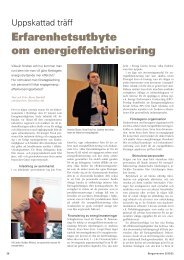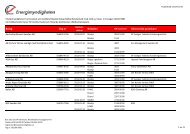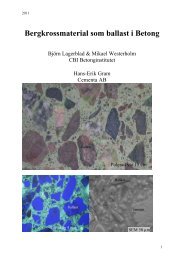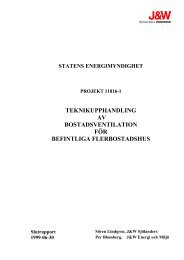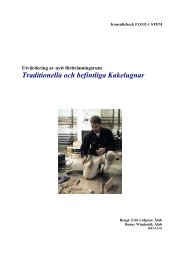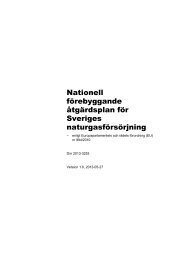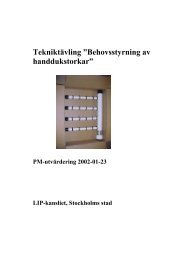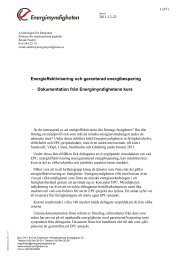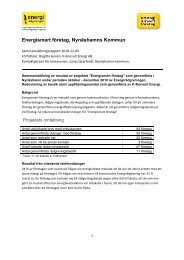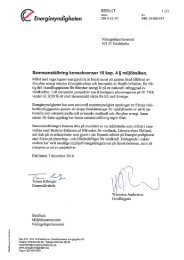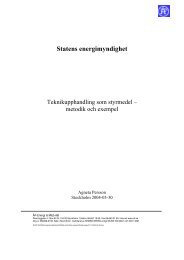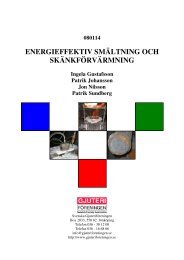ATAC i system - Energimyndigheten
ATAC i system - Energimyndigheten
ATAC i system - Energimyndigheten
Create successful ePaper yourself
Turn your PDF publications into a flip-book with our unique Google optimized e-Paper software.
Katalytisk förbränning av förgasat biobränsle i gasturbiner -<br />
Catalytic Combustion of Gasified Biomass in Gas Turbines<br />
Projekt nr: P7057-4<br />
Projektledare: Prof. Torsten Fransson<br />
Projektdeltagare: Jürgen Jacoby (100%), Philippe Thevenin (50%), Jan Fredriksson<br />
(10%)<br />
Projektets varaktighet: 2000-04-01 till 2002-03-31<br />
Beviljade medel: 3 530 000 kr<br />
Referensgrupp: Rolf Gabrielsson (VAC), Lars Waldheim (TPS), Magnus Callavik<br />
(ABB Corp. Research), Sven Järås (Kemisk Tekonologi-KTH)<br />
___________________________________________________________________________<br />
Projektbeskrivning (Project description):<br />
This project attempts to combine two technologies in the field of energy production, which<br />
have experienced an increasing interest in research, namely gasified biomass and catalytic<br />
combustion. Catalytic combustion has been investigated by numerous research groups in both<br />
academic and commercial fields as it offers high efficiency combustion at low emission<br />
levels, a feature which has become essential to meet today’s stringent emission regulations.<br />
Single-digit emissions levels of nitrogen oxides, carbon monoxides and unburnt hydrocarbons<br />
have already been demonstrated using natural gas as a fuel source. Gasified biomass offers the<br />
potential for reducing net emissions of carbon dioxide as a greenhouse gas. A reduction of<br />
nitrogen oxides as a combustion product is of interest as its oxidation in the earth atmosphere<br />
results in the formation of secondary pollutants which are potentially more harmful than the<br />
precursor itself. The purpose of the catalyst is to allow a stable reaction process of lean fuelto-air<br />
mixtures. Biomass is an attractive fuel source due to its abundance. It has to be said<br />
though that this statement is only valid in certain geographical regions of the world. Through<br />
advanced gasification technologies, e.g. the circulating fluidized bed technology, biomass can<br />
be converted into a combustible gas which can in turn be used to fire a gas turbine for energy<br />
production. Gasified biomass has some distinct characteristics resulting in great demands on<br />
the combustor. Even though rich in hydrogen and carbon monoxide, its low-heating value<br />
requires a technique to maintain a stable combustion, difficult to achieve via flame<br />
combustion. Furthermore it has a potentially high level of ammonia, which may generate<br />
emissions of nitrogen oxide.<br />
Projektets mål (Project goal):<br />
Overall aim of the project is to investigate the feasibility of firing a gas turbine which is<br />
equipped with a catalytic combustion chamber with a low-heating value fuel derived from<br />
gasification of biomass, e.g. wood chips. Monitoring of the emission levels is essential in<br />
order to meet the required standards.<br />
Jürgen Jacoby defended his Ph.D. thesis on Oct 25 th , 2001, preliminary date for the<br />
disputation of Philippe Thevenin is April 2002.<br />
Uppnådda resultat (Results):<br />
A test facility for studying the catalytic combustion of a gas similar in its characteristics to<br />
gasified biomass has been designed and successfully taken into service. The tested catalyst<br />
arrangements and catalyst properties are listed in Table 1.



